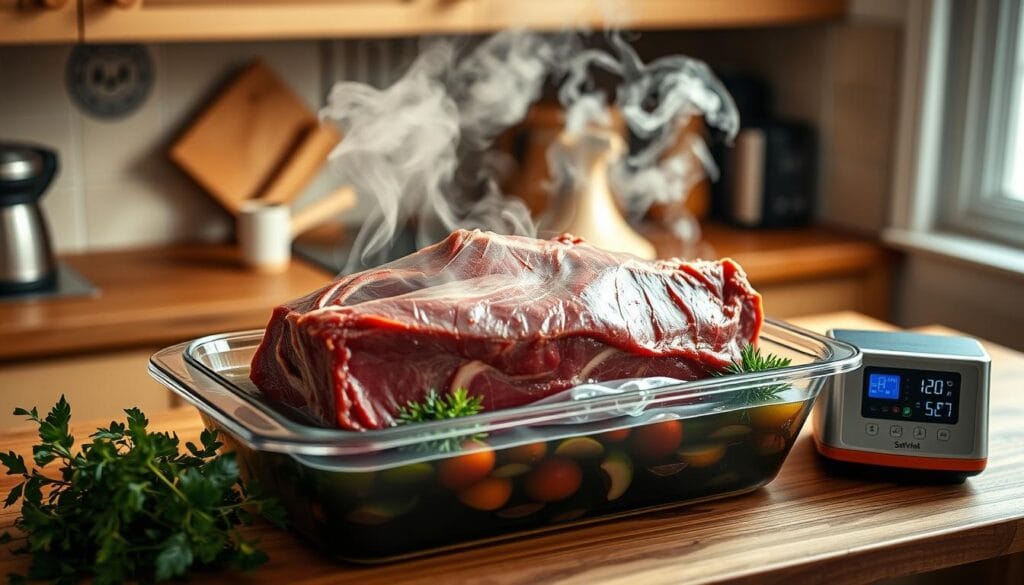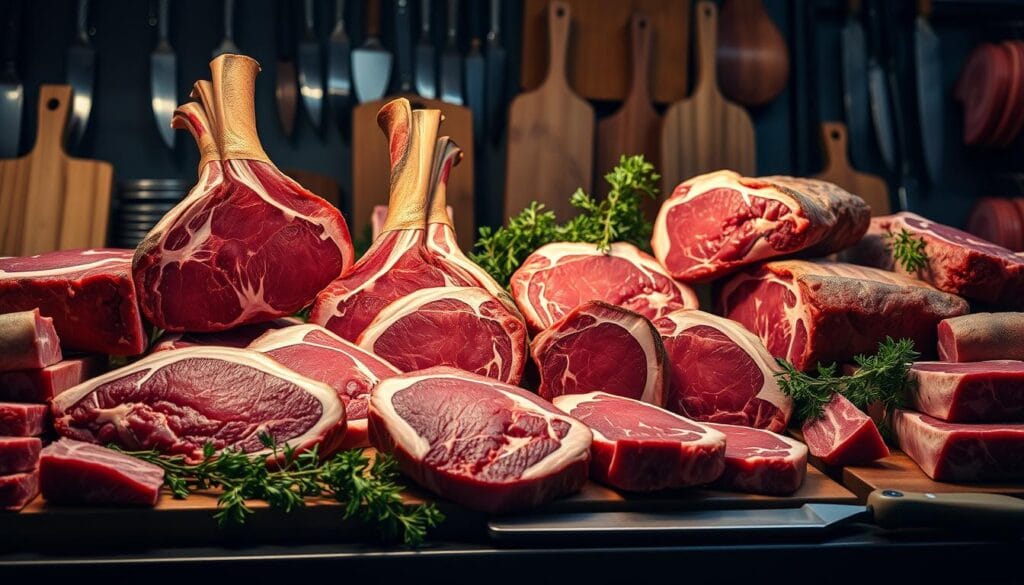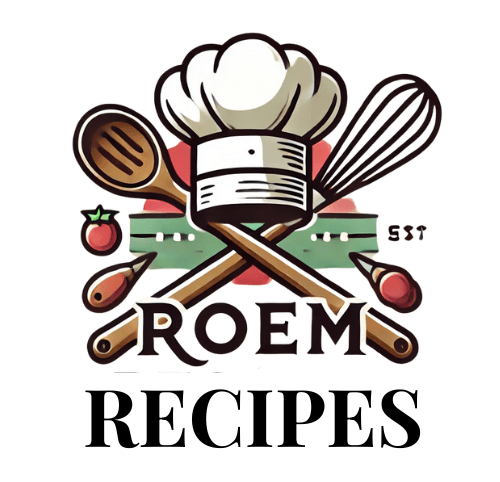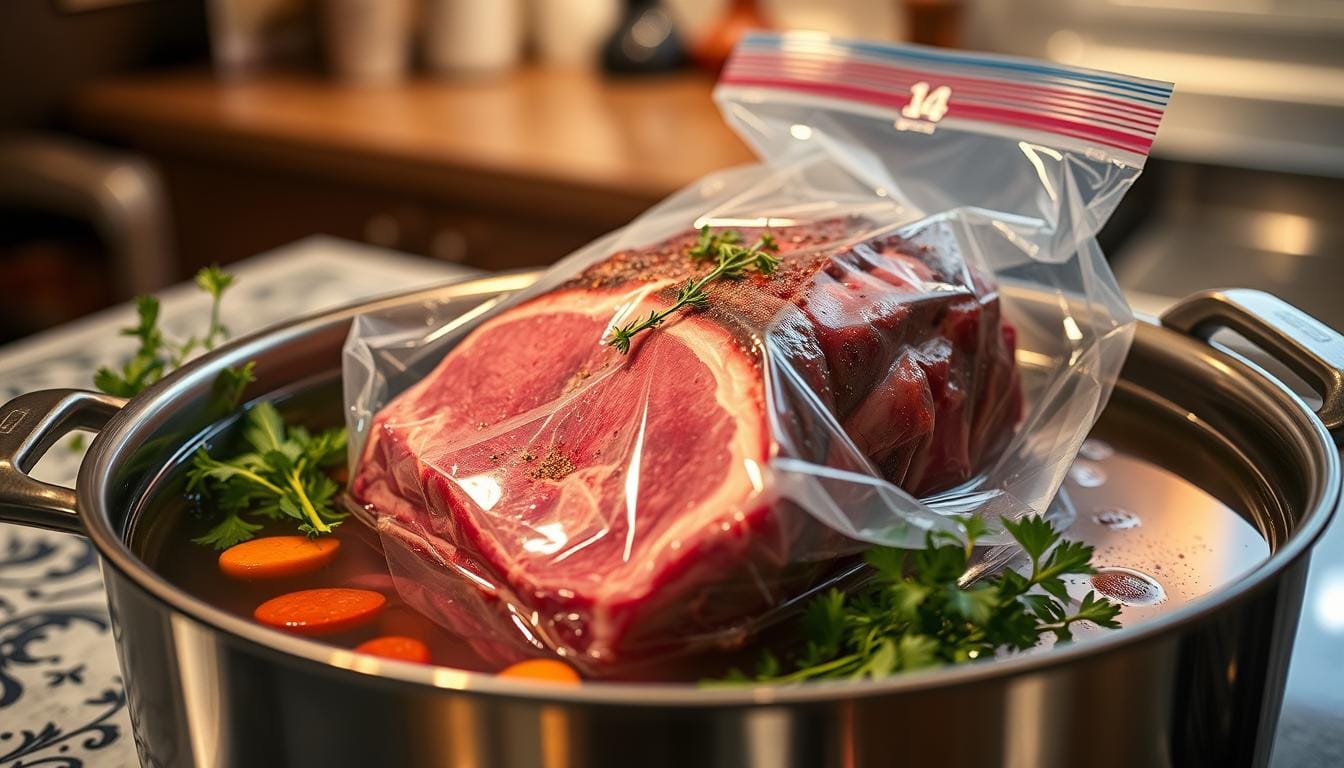Imagine a prime rib that’s so tender, it just melts in your mouth. Each bite is a burst of flavor. For years, I tried to get that perfect prime rib at home. But it wasn’t until I found sous vide cooking that I succeeded.
Sous vide cooking changes the game for home chefs. It keeps the temperature just right, so your meat is cooked evenly. This means no more overcooked edges like you get with traditional roasting.
If you love cooking or just want to make your dinners better, try the best sous vide prime rib recipe. It will change how you cook this classic beef cut.
Key Takeaways
- Sous vide ensures consistent, precise cooking temperatures
- Eliminates the risk of overcooking prime rib
- Delivers restaurant-quality results at home
- Works for both experienced and novice cooks
- Guarantees tender, juicy meat every time
Table of Contents
Understanding Sous Vide Prime Rib Fundamentals
Sous vide cooking turns prime rib into a true art. It makes the meat tender and flavorful. Learning to sous vide prime rib opens up a new world of cooking.

The secret of sous vide is its exact temperature control. It’s different from regular cooking. This method cooks your prime rib perfectly, without overcooking it.
What Makes Sous Vide Perfect for Prime Rib
Here are the key benefits of sous vide prime rib:
- Breaks down connective tissues for maximum tenderness
- Ensures uniform cooking throughout the roast
- Maintains optimal moisture and flavor
- Provides consistent results every time
Benefits of Precision Temperature Control
| Doneness Level | Internal Temperature | Cooking Characteristics |
|---|---|---|
| Rare | 120-125°F | Deep red center, extremely tender |
| Medium-Rare | 125-135°F | Ideal for prime rib, pink center |
| Medium | 135-140°F | Slightly less tender, light pink center |
Key Equipment Requirements
To cook sous vide prime rib, you’ll need:
- Immersion circulator
- Large water bath container
- Vacuum sealer
- High-quality meat thermometer
- Sharp kitchen torch or hot skillet for searing
“Precision is the key to transforming a good prime rib into an extraordinary culinary experience.” – Professional Chef
By grasping these basics, you’re ready to make top-notch prime rib at home.
Selecting the Perfect Prime Rib Cut
Choosing the right prime rib cut is key for a great sous vide meal. The cut you pick affects the flavor, tenderness, and quality of your roast.
Prime vs Choice Grade Selection
There are two main beef grades: Prime and Choice. Prime has more marbling, which means richer flavor and tender meat. Sous vide prime rib techniques work well with both, but Prime is more luxurious.
| Beef Grade | Marbling | Flavor Intensity | Price Point |
|---|---|---|---|
| Prime | High | Extremely Rich | Higher |
| Choice | Moderate | Good | More Affordable |
Bone-in vs Boneless Options
Whether you pick bone-in or boneless, the sous vide temperature stays the same. Bone-in roasts offer:
- Deeper flavor
- More moisture
- Better heat distribution
Size and Weight Guidelines
Plan your prime rib roast with these serving tips:
- Bone-in roast: 5 pounds serves 6-8 people
- Boneless roast: 3 pounds serves 6-8 people
- Recommended cooking time: 8 hours at 132°F for medium-rare

“The right cut makes all the difference in creating a memorable dining experience.”
Knowing these selection tips will help you pick the best prime rib for your sous vide cooking.
Essential Equipment and Tools for Success
Making the perfect sous vide prime rib is more than just cooking skills. It needs the right tools for precision and taste. Your sous vide prime rib cooking guide begins with choosing top-quality tools.
The key to sous vide cooking is an immersion circulator. It keeps the water at the exact temperature, ensuring even cooking. A digital meat thermometer is your best friend. It lets you check the meat’s doneness with great accuracy.
- Immersion circulator with precise temperature control
- Large water-tight cooking container
- Vacuum sealer or high-quality food-grade bags
- Digital meat thermometer
- Cast-iron skillet for final searing
For delicious sous vide prime rib, get a good vacuum sealer. It removes all air, keeping the meat sealed and cooking evenly. No vacuum sealer? Heavy-duty zip-lock bags work well with the water displacement method.
| Equipment | Purpose | Recommended Temperature Range |
|---|---|---|
| Immersion Circulator | Precise Temperature Control | 132°F for Medium Rare |
| Digital Thermometer | Accuracy Check | Up to 500°F |
| Vacuum Sealer | Airtight Sealing | Prevents Moisture Loss |
“The right tools transform good cooking into extraordinary culinary experiences.” – Professional Chef
Other useful items include sous vide weights and a strong cast-iron skillet. These help achieve a perfect golden-brown crust after cooking. With these tools, you can make restaurant-quality prime rib at home.
Temperature and Timing Mastery
Mastering the sous vide prime rib cooking guide needs precision and knowing about temperature control. Sous vide cooking is special because it always gives perfect results. This is true every time you cook this luxurious meat.
Optimal Temperature Ranges
The right temperature for your sous vide prime rib is key for the perfect doneness. Here are the temperature ranges:
- Rare: 131°F (55°C)
- Medium Rare: 135°F (57°C)
- Medium: 140°F (60°C)
- Medium Well: 145°F (63°C)
Cooking Duration Guidelines
The cooking time for your prime rib depends on size and how tender you want it. Generally, sous vide prime rib needs:
| Roast Weight | Cooking Time |
|---|---|
| 3-4 pounds | 6-8 hours |
| 5-6 pounds | 8-10 hours |
Temperature Monitoring Tips
Keeping a close eye on temperature is crucial for sous vide success. Use a reliable digital thermometer. This ensures your water bath stays at a steady temperature during cooking.
“Precision is the heart of sous vide cooking. Your thermometer is your best kitchen companion.”
Remember, patience is key. The slow cooking method makes your prime rib tender and juicy. It will wow even the pickiest meat lovers.
Seasoning and Marinade Techniques for Maximum Flavor
Getting the best flavor from sous vide prime rib starts with the right seasoning. Your prime rib needs a special blend to turn it into a dish to remember. Knowing how seasonings work with the meat’s taste is key.
“Great seasoning is the secret weapon of extraordinary prime rib preparation.” – Professional Chef
For amazing flavor, focus on these key seasonings:
- Coarse sea salt for deep flavor penetration
- Freshly ground black pepper for robust heat
- Minced garlic for aromatic complexity
- Fresh herbs like rosemary and thyme for earthy undertones
Timing is everything when seasoning your sous vide prime rib. Pre-seasoning lets salt and herbs soak into the meat, making it taste better. A professional seasoning approach is to add your spice mix hours before cooking. This lets the flavors mix well.
| Seasoning Type | Flavor Profile | Recommended Amount |
|---|---|---|
| Kosher Salt | Classic, Enhances Meat Flavor | 1-2 tablespoons |
| Black Pepper | Sharp, Spicy | 1 tablespoon |
| Fresh Herbs | Aromatic, Earthy | 1 tablespoon each |
Pro tip: Try different herb mixes to make your own sous vide prime rib recipe. The goal is to find the right balance of flavors that highlight the prime rib’s natural taste.
Step-by-Step Sous Vide Process
Learning to sous vide prime rib perfectly needs focus and detail. This guide will show you how to cook it step by step.
Preparation Phase
Start by getting the right ingredients and tools. Choose a prime rib with ¼ to ½ inch fat. Your list includes:
- Trim excess fat from the roast
- Pat meat dry with paper towels
- Season generously with kosher salt and black pepper
- Prepare vacuum sealer or high-quality zip-lock bags
Cooking Process
Setting up your water bath is key for great results. For medium-rare, set your circulator to 135°F. Seal the seasoned prime rib well to cook evenly.
Put the sealed meat in the water bath. Cooking times depend on the roast size:
- Smaller cuts: Approximately 3 hours
- Larger roasts: Up to 8 hours
- Recommended maximum time: 8 hours for optimal texture
Post-Cooking Steps
When the prime rib is cooked, take it out of the bath. Dry it well. Then, sear it to get a golden-brown crust.
“Precision is the secret to sous vide perfection” – Professional Chef Recommendation
Creating the Perfect Crust Post-Sous Vide
After mastering the sous vide prime rib technique, the final step is achieving that golden-brown exterior. This transforms your roast from good to extraordinary. The secret lies in the Maillard reaction, a culinary magic that develops complex flavors through high-heat interaction between proteins and sugars.
Top sous vide prime rib techniques focus on creating a spectacular crust without compromising the tender interior. Here are your primary searing methods:
- Cast-Iron Skillet Sear
- Preheat skillet to extremely high temperature
- Sear for 6 to 8 minutes total
- Turn meat every 1-2 minutes for even browning
- Broiler Method
- Set broiler to maximum temperature (550°F)
- Place meat on wire rack
- Broil 4 to 8 minutes
- Kitchen Torch Technique
- Use consistent sweeping motions
- Maintain even distance from meat
- Rotate to prevent burning
“The perfect sear is about intensity, not duration – quick and hot is your mantra.” – Professional Chef’s Tip
Tips for cooking sous vide prime rib demand precision. Pat your meat completely dry before searing to ensure maximum browning. A quick 1-2 minute rest after searing allows the crust to set perfectly, sealing in those incredible flavors you’ve carefully developed through sous vide cooking.
Complementary Sauces and Accompaniments
Improving your sous vide prime rib is more than just cooking it right. The right sauces and sides can turn your meal into a work of art. They bring out the rich flavors of the sous vide prime rib.
Classic Au Jus Preparation
Making a true au jus needs careful steps. Begin by saving the meat drippings from your sous vide prime rib. Mix these with:
- Beef stock
- Red wine
- Fresh herbs
- Minced garlic
Sauce Pairing Suggestions
| Sauce Type | Flavor Profile | Best Pairing |
|---|---|---|
| Horseradish Cream | Sharp and creamy | Medium-rare prime rib |
| Béarnaise | Rich and herbal | Tender sous vide roast |
| Red Wine Reduction | Complex and deep | Well-seasoned prime rib |
Side Dish Recommendations
Pair your prime rib with these classic sides:
- Roasted root vegetables
- Creamy mashed potatoes
- Crisp green salad
- Buttered asparagus
“The right sauce can elevate a good prime rib to an extraordinary dining experience.”
The secret to a great meal is balancing flavors and textures. Your sous vide prime rib needs sides that boost its flavor without overpowering it.
FAQ
What is sous vide cooking for prime rib?
What equipment do I need to cook prime rib sous vide?
How long does it take to cook prime rib using sous vide?
What’s the best way to get a crispy crust after sous vide cooking?
Can I season the prime rib before sous vide cooking?
What’s the difference between Prime and Choice grade beef for sous vide?
Is sous vide prime rib suitable for special occasions?
What sauces pair well with sous vide prime rib?
Can I cook a bone-in or boneless prime rib using sous vide?
How do I store and reheat leftover sous vide prime rib?
Conclusion
Your sous vide prime rib adventure turns home cooking into a pro-level experience. You learn about precise temperature control and follow key techniques. This way, you can make meals that wow even the pickiest eaters. Sous vide ensures your meat is always perfectly cooked.
With the best sous vide prime rib recipe, you open a world of flavors and tenderness. It keeps temperatures between 54°C and 130°F for a juicy, medium-rare result. This is something traditional cooking can’t match. Your sous vide equipment lets you make amazing meals at home.
Remember, practice makes perfect with sous vide prime rib. Each time you cook, you get better. You can try new seasonings, searing methods, and sides. Whether it’s for a special event or a casual dinner, you can make pro-level dishes in your kitchen.
Your cooking skills will grow as you master sous vide. The precision and consistency of sous vide cooking will change how you make prime rib. Every meal will be a special experience.

